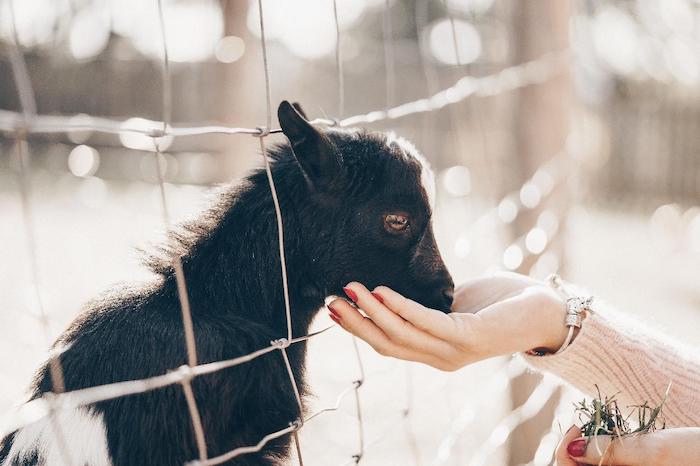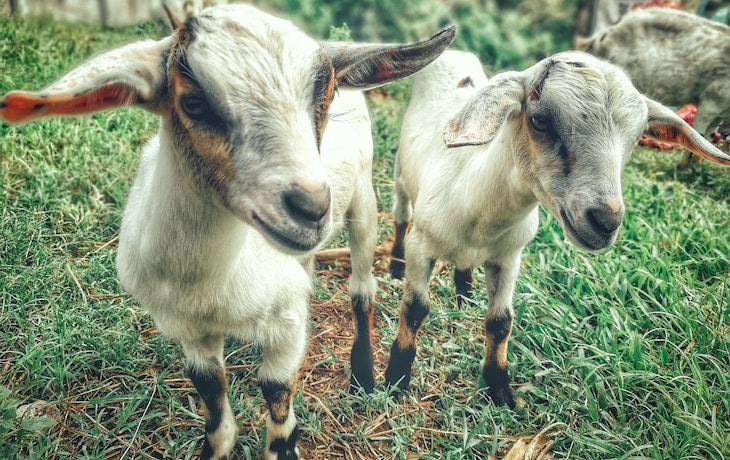Many new homesteaders, when asking what to do about the overgrowth of brush or brambles, often get the response: “Just get some goats,” due to their reputation for eating grass, briars, and pretty much anything.
When I bought my five-acre property in 2017, I intended to buy some goats straightaway for milk and meat, and to cut down on mowing. Thankfully, I’m a meticulous researcher, and I soon learned that goats are a lot more complicated than you might think.
The intent of this article isn’t to dissuade you from investing in goats. Goats are great! But I’m tired of seeing people blithely telling new or aspiring homesteaders to “just buy some goats” as if that’s not going to introduce a whole new set of complications to their lives.
Some things to consider:
- Do you even like goat meat and/or milk? (The flavor can be quite strong depending on what they eat.)
- Who will watch your goats when you’re out of town?
- How will you transport your goats?
- Who can you call if your goats get sick?
- Where will you buy hay and feed?
If you’re serious about the responsibilities of goat ownership, I recommend two books: Storey’s Guide to Raising Meat Goats and Storey’s Guide to Raising Dairy Goats. They’re technical and a little dry, but they are the gold standard reference books for the aspiring goat herder. A good free resource is Fias Co Farm, which has a wealth of information on raising goats.
But probably the best thing you can do is to make contacts with other goat people, visit their farms, and spend time with goats to decide if you actually want to be around them. Plus, if you make the leap you’ll have friends who can offer advice and support.
It’s hard to give exact figures, given the wonkiness of pricing and your own needs, but I would budget at least $1,000 to get started, including the goats themselves, fencing, and gear.
Important bits:
- Goats can offer many benefits: brush clearing, meat, milk, fur, and companionship.
- Goats are difficult to fence. Your biggest goat-related expense (and frustration) might be keeping them contained.
- Goats can be used as a lawnmower replacement, but the yard won’t look as landscaped as if a machine did it.
- When goats get loose they’ll eat gardens and shrubbery, and might even climb onto your car or roof.
- Despite their propensity to eat seemingly everything, goats are surprisingly picky eaters and you need special feed troughs to keep them from wasting feed.
- Just as you trim your fingernails and toenails, you need to trim goat hooves.
- You need supplies to treat goat injuries, diseases, and parasites.
- Any kind of livestock can be a messy business. Be prepared to do gross or even heartbreaking stuff.
Why raise goats?
Before I get into some of the harsh realities of raising goats, let’s discuss why you’d bother in the first place. Goats offer many benefits to a homestead:
- Goats eat grass and brush, helping to make land maintenance a bit easier.
- Goats are easier to transport than cattle.
- Goat manure is an excellent fertilizer for the garden.
- They can provide a fresh supply of milk you can use not only for drinking, but making cheese, butter, yogurt, and other dairy products.
- Goat meat can be pretty tasty. Goats are much easier to handle and process than cattle.
- Goat fur and hide are useful if you have the skill and patience.
Plus, goats can be charming or even adorable. Many people just enjoy having them as pets.
After chickens and rabbits, goats are one of the best animals to keep on a small homestead. That being said, you should go in with both eyes open to the many drawbacks and responsibilities of raising goats.
Goats are hard to contain
Goats are notoriously hard to fence. There’s an old saying about how you test a goat fence: throw a five-gallon bucket of water at it, and if any water gets through, it’s not goatproof.
Goats are escape artists. They’re natural climbers — they climb straight up rock walls in the wild. Likewise, they’ll climb straight up many types of fences, like cattle panels. And if they don’t climb up the fence, they’ll stick their head through and possibly get stuck.

Goats will test your fence. They will push against it, try to slide under it, and stand on objects in their pen to try to get over it. And if, no when, they escape, the results can be disastrous. They’ll go straight for your garden vegetables, rose bushes, or any forage that looks tasty. Even worse, they may go after your neighbor’s yard.
And don’t be shocked to find one on your car or even on your roof.

You can’t cheap out on goat fence, and goats are more expensive to fence than most animals. One of the easiest types of fence to install is panels since they’re solid and don’t need to be stretched by machinery. A 16-foot cattle panel costs $25 at Tractor Supply, while the same panel intended for goats costs $34.99. Plus, panels are a pain to transport: you either have to bend them to fit them in the bed of a pickup truck (good luck getting them flat again), transport them on a long trailer (those aren’t cheap), or haul them on a flatbed truck (again, not cheap).
Many goat keepers swear by electric net fencing. Traditional single-strand electric fencing is insufficient to contain goats, but the nets are quite effective and as a plus, they’re fairly easy to move, so you can rotate your goats around to browse weedy areas. Premier 1 sells a starter kit for $470 that includes the net, a solar fence energizer, fence tester, and support posts.
One problem with electric net is that tall grass can ground the fence and make it useless. Unfortunately, if you want goats to do your mowing for you, that can be a problem. You’ll have to use a string trimmer to cut the grass where the fence will go or use an herbicide spray. Once you have a good pattern established, you can scoot the fence around so they eat the tall grass where the fence was parked, but that takes time.
And if you’re thinking that you can just plop goats down in a field of thistles and leave them be, guess again!
Goats are picky eaters
Contrary to popular belief, goats can’t survive from chewing on tin cans. Yes, they’ll nibble just about anything, but just like any other animal, they need feed — either hay (about $3-4 a bale where I live) or goat pellets, which cost about $17 for 50 pounds at Tractor Supply. Adult goats eat between 2 to 4 pounds daily, so if you’re lucky each goat will eat a 50-pound bag of feed per month.
There are a lot of variables there. Goats with plenty to forage might eat less. Older, nursing, and pregnant goats will eat much more — up to seven pounds per day!
You probably anticipated buying feed, but what you might not know is that goats are actually picky eaters. You need to buy or build special hay feeders to keep hay off the ground because once it touches the ground, a goat won’t eat it. Goats like to pee on their hay, and once they do, they won’t touch it again. Goats get tired of feed quickly, so you have to mix it up, because if they get bored they’ll stop eating. But they’ll happily eat your rose bushes and fruit trees. Grr…
Thankfully you can buy a wire hay feeder online for around $60.
Another thing to know is that there are a lot of common plants that are poisonous to goats. Some you might expect, like death camas, but others you might not, like buckwheat, cherry, elderberry, Johnson grass, ivy, and sorghum. If you just let your goats loose in a field without checking for the many plants toxic to them, you could end up with sick or dead goats.
The good news is goats are smart enough to usually avoid plants poisonous to them, but they may eat them anyway if they get hungry or bored enough.
You have to trim their hooves
Different sorts of goats require special maintenance, but every goat needs to have its hooves trimmed. Just as your fingernails and toenails grow too long and have to be trimmed, so do goat hooves. Goats do not enjoy this. At minimum, you need some $10-15 goat hoof trimmers. Many people also find a milking stand and some stop-bleed powder useful, but you may be able to get by without those. If you can find a professional to trim hooves, expect to pay at least $15 per goat, and upwards of $50 or more, depending on your area.
If you’ve ever trimmed a cat or dog’s claws, it’s a somewhat similar process. Except a goat is much larger and stronger than most dogs and cats. Then again, I have some scars from trimming cat claws. In any case, it’s not a task for the faint of heart.
Goats need first aid
Experienced goat owners recommend keeping a first-aid kit for your goats. Yes, they will eat briars and brambles, but that doesn’t mean they’re made out of stone. They get as cut up as you do walking through briars. Expect to keep much of the same stuff in your goat first-aid kit that you keep in your human first aid kits, along with some special items like a drencher for giving medicine.
Also in your first-aid kit, you’ll want some dewormer, because goats are notoriously prone to gastrointestinal worms. You can buy pelleted dewormer you can mix with their feed, or liquid stuff you have to shoot in their mouth.
Another thing you’ll probably want to do with your goats is to disbud them. Goat horns can be a danger, so many people burn the buds of young goats with a searing hot pipe or an electric cauterizer to keep them from growing. You can pay a veterinarian to do that, but it can get expensive if you have a large herd, and that’s assuming you can find a willing veterinarian.
The cost of disbudding can be incredibly cheap if you heat up a pipe with a torch or with a forge, though electric disbudding irons usually cost around $100 or more. Veterinarian prices are all over the map — I’ve heard anywhere from $8 to over $80 per goat.
There will be blood
I only keep chickens, but I offer some standard advice to anyone interested in livestock: don’t do it unless you’re prepared to deal with death. Just the other morning I woke up to one of my oldest layers laying on the ground dead. It happens. Once, I woke up to one of my hens having been ripped in two by a raccoon.
It’s the same with goats. They might fall over dead. They might be eaten by a predator. You might need to kill one at some point, especially if you’re planning to raise them for meat. Do you have the stomach to do that? Are you capable of processing a goat? Unfortunately, there’s only one way to find out for sure.
Imagine this gruesome scenario: you hear a noise in the middle of the night and run to your goats. You find one of your goats in the jaws of a coyote, its neck snapped, but still alive. Would you be able to take down the coyote to protect your goats and put the injured goat out of its misery?
OK, that’s an extreme example, but when you own livestock you have to be prepared for messy situations. That’s especially true if you keep a buck (a male goat with its testicles intact) around for breeding. Bucks get aggressive, pee everywhere, and can smell horrible during rutting season. And because of their hormones, buck meat is practically inedible.
If you decide to keep a buck, you probably only want one, so you’ll want to castrate any other young males you have to turn them into wethers. Thankfully you don’t need a blade for this, you can place a special band called an elastrator around the goat’s scrotum, which will take care of everything without blood. A kit including the bands and special pliers to apply them costs around $25.
Even so, that might be more than you signed up for just to get rid of brush!

You are reporting the comment """ by on